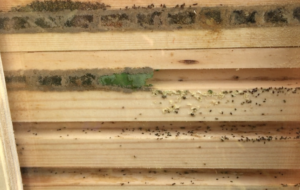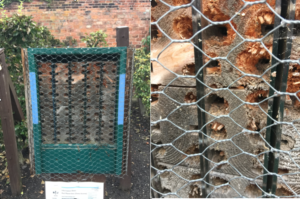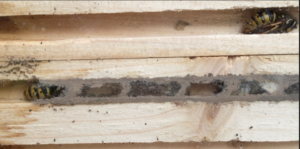Reasons to remove your solitary bee nest boxes
1. Parasitoids wasps, e.g. Monodontomerus
This Nurturing Nature Orchard solitary bee nest box was completely full of Red Mason bee larvae, when in my own garden a short while after this photograph was taken. The larvae inside become the target for Monodontomerus wasps that actively seek out the bee cocoons in which to lay their eggs.
2. Summer bees, e.g. Leafcutters
Occasionally, a Red Mason female may only partially use a nesting cavity which will then be used by a Leafcutter bee. This will cause problems as the Red Mason bees emerge first and to exit they will have to chew through the Leafcutter bee cells and Leafcutter cocoons directly in front of them, thereby killing them. To minimise these threats, all of my Red Mason bee nesting units, if used by them, whether full or not, are removed to a place of safety and replaced by fresh clean units in readiness for the summer bees.
The clean fresh nesting units allow other summer bees, e.g. Leafcutters and others, to make use of the nest box whilst the Red Mason bee larvae are safe out of harms way. This nesting unit is jam packed full!
3. Great tits and Blue tits
Great tits and even Blue tits will damage the entrances when searching for food. Luckily they probably would not be able to reach many if any of the cocoons inside.
4. Pteromalus wasps
Again, for best practice, once these units are full OR the bees have stopped nesting, they are removed as the Leafcutter or other summer bee larvae become a target for the Pteromalus wasps. Surprise, surprise, these emerge just as the leafcutters near the end of their nesting period!
5. Woodpecker damage
Besides the parasitoid wasps mentioned, there are other pests and predators that want to dine upon your bees! Some like the woodpecker, besides predating upon your cocoons, will greatly damage the nesting units to get at them.
Actually placed in an orchard, the wire mesh was put up AFTER the woodpeckers had damaged the nest blocks. Although I do have woodpeckers visiting my bird feeders, I have never been troubled by them myself when the bees are actively nesting nor in autumn onwards as there is nothing there for them, other than the feeders! I am aware that woodpeckers become interested in the cocoons themselves in the autumn and winter. Cocoons are static and such a rich resource with minimal energy required to reach them. Hopefully it ate some parasitoid wasps as well! Click on the photograph and you can clearly see what can happen if the nest boxes are left out. There is a lot of work required here to clean the splinters away and make the nesting blocks safe for next years bees. Some nesting blocks will have to be replaced.
6. Weather and maintenance
I am now left with empty nest boxes on the walls and fences and are fully open to the winds, elements and inclement weather. For best practice and for the longevity of the nest boxes, they are removed, placed in the garage and away from the weather conditions. This allows them dry, to be cleaned, painted and maintained/repaired if required.
7. Temporary home for other insects
There were 4 queen wasps inside this one nest box, several green bottle flies, an earwig and a spider had made its web inside one of the cavities!
If you can think of any more reasons to bring in your solitary bee box, please get in touch. Thanks! George
Not sure which bees you have?
For info and link to buy an excellent book Field Guide to the Bees of Great Britain and Ireland by Steven Falk
An extremely useful resource supports this book by a special web site feature within Steve Falk’s Flickr web site which furnishes extra photos and other useful resources to assist with identification.
Interested in Citizen Science and pollinators? The Buzz Club







Hi George. Agree your comments about the woodpecker. Have experienced this before. Pleased to say all my boxes are safely stored for winter wrapped In a fine Garden fleece to stop any invaders!
Best regards marian
Nice one Marian, at least someone listens!!!!! Nice to hear from you. Best, George
Our bee hotels 2 years running have been damaged and emptied just after they were filled.
So here we are May the 26th and I have had to remove a box and store it to save the remaining bee larvae/eggs.
Some of it does look like woodpecker damage or something else with a long beak/tongue.
Any other thoughts anyone.
Could well be or some other birds. Blue and great tits will try to get at such a glorious food supply. Cheers G